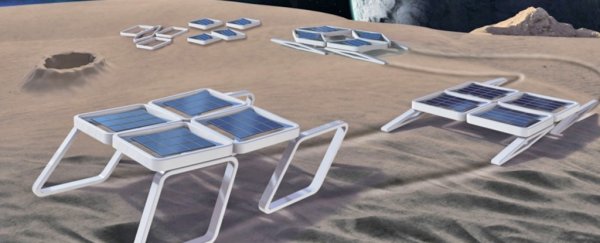Researchers have built a soft, motor-free robot that moves in response to an electric current – and its supple, compact frame makes it equally suitable for exploring underwater seabeds and the surface of the Moon.
While conventional, 'hard' robots definitely have their uses, they're bulky, heavy, rigid, and expensive, which is why scientists are exploring options for soft robots too, and the new designs are among the most promising yet.
The makers of the DeployBot robot, from Seoul National University in South Korea, say it can be easily dispatched in a variety of situations because its internal mechanics and external frame are kept down to a minimum. It's essentially a flat-pack robot.
"The main advantage of this modular robot is robustness in various environments due to lack of mechanical systems such as motors and gears," one of the team, Sung-Hoon Ahn, told Lisa Zyga at Phys.org.
"Thus, problems facing motor-based robots, such as sealing and lubrication of mechanical systems in water or space environments, are not a problem for the smart actuator."
What makes DeployBot stand out from other similar projects is that it can deploy itself and move around without any extra motors.
Made from eight modules – four for the body plus four legs – it starts off flat and then pops up into a shape roughly resembling a square, with embedded magnets connecting and locking the multiple modules together.
Thanks to the shape-memory alloy wires in its frame, wires which automatically return to their original form when heated, it can move around when electricity is applied to the wires.
The current causes the flexible parts of the robot to contract and bend, and it even has different walking styles depending on how the current is applied. Despite its soft nature, it's strong enough to carry loads, and repairing it is as easy as replacing one of the modules.
As far as space travel goes, softer robots mean lower costs and less weight, which in turn means less rocket fuel to get the kit up in space in the first place, saving a lot of money.
We recently reported on another soft structure project out of the Georgia Institute of Technology, involving struts and cables that could be packed flat and then reheated to restore their original form. The technology might one day be used to build structures or communications equipment out in space.
It's all very promising stuff, though we'll have to wait a while before DeployBot can trek across an alien planet or take a trip under the ocean. Its maximum speed is currently a little over 2 metres (6.6 feet) per hour, and it takes 21 strides to make a 90-degree turn.
Those aren't insurmountable problems though, and the makers of DeployBot say their design can be easily adapted and improved upon in the future.
"This robot can serve as the first step toward a new class of soft robots that is modular, self-deploying, and capable of locomotion 'out of the box'," write the researchers.
A paper on DeployBot has been published in Materials Horizons.
